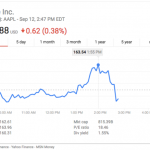Apple Q4’s Earnings Are A Prelude To The Holiday Quarter Forecast
Apple will report its fiscal fourth quarter earnings Thursday after the bell, and the numbers may well show depressed iPhone sales and lots of apprehension about supply and demand for the new iPhone X, which will go on sale this Friday.
The company’s fourth quarter, which covers July, August, and September, typically starts an upswing in seasonal results after a drowsy Q2 and Q3, culminating in a big Q1 over the holiday season.
Thomson Reuters analysts expect Apple to announce $50.79 billion in revenues for the quarter. A month ago Apple forecast between $49 billion and $52 billion. Apple reported Q4 revenues of $46.85 last year.
The fourth quarter is also when the numbers start to show sales of the new phones Apple announces in September. This year, the iPhone 8, iPhone 8 Plus, and iPhone X were all announced September 12. So the Q4 results will capture some initial figures on the iPhone 8 and iPhone 8 Plus, which started shipping September 22. Keep in mind, though, those may have been depressed by people waiting to buy the fancier iPhone X, or at least read the reviews before finalizing a buying decision.
Analysts polled by Estimize.com believe the company sold 48.16 million iPhones in the September-ending quarter. Analyst Neil Cybart believes that number includes sales of about 12 million iPhone 8 and iPhone 8 Plus units in the last part of September. “…There is evidence of customer demand for iPhone 8/8 Plus being down by about 30% year-over-year in comparison to the iPhone 7/7 Plus launch in 2016,” Cybart wrote in a recent brief.
Holiday Sales Will Tell The Tale
Apple derives two-thirds of its revenue, give or take, from iPhone sales, so its new phone releases–and consumers’ reaction to them around the world–are of supreme importance at earnings time. We’ll know a lot more about Apple’s performance when it reports earnings for its holiday quarter, the first full quarter when both the iPhone 8 models and the iPhone X will be on sale.
The most interesting part of the earnings report Thursday will be Apple’s forecast for sales of the phones. Sales of the iPhone X might be seriously constrained by supply shortfalls owing to problems with the new facial recognition technology, numerous reports have said and our sources have confirmed. But how constrained the supply will be, nobody knows yet.
“Production problems might lead to weaker numbers for the next two quarters,” writes Investing.com senior market analyst Clement Thibault in a research note.
“We would accept an all-time high valuation on the stock if the iPhone X rollout were going smoothly,” Thibault writes. “Right now, the availability of the flagship is limited, and the holiday season is almost here.”
Some of the analysts we’ve spoken with say the iPhone X supply constraints could last up to six months. Apple’s site is currently reporting a 5-6 week lead time for new orders.
Looking To China
Apple’s critical Chinese market has yielded disappointing results in recent quarters, and the problems may continue, if in a different form.
On the bright side, a recent Canalys report said Apple shipped 11 million iPhones in China in the September-ending quarter, representing a 40% uptick from the year-earlier quarter. iPhone sales in China had dropped by half since 2016.
And early reports say that Chinese consumers are very excited to buy the new iPhone X, but the supply problems will affect the Chinese market like everywhere else. This could create some bad feeling in a burgeoning market where Apple still has a lot of growing to do and needs to win hearts and minds.
Services Are Go
It’s very possible that Apple’s phone business is simply maturing. The dramatic sales jumps of the past (see: iPhone 6) may not be so dramatic in the future. Apple may continue to expand its selection of iPhones, taking some of the spotlight off individual models. And as the global market for smartphones softens, the iPhone business may one day no longer be large enough to contribute its current share of Apple revenue.
Enter Apple’s growing services business, which is more constant, and which relies not on new device sales but rather utilizes iDevices already in use. Apple can sell services through platforms such as the App Store, Apple Music, iTunes, Apple Pay, and iCloud to users all year long (with no sales seasonality), and can continue to coax users to buy more.
In 2016, when services revenues were about $7 billion, Apple said it wanted to double the business by 2020. Most analysts expect the company to have made progress down that path in Q4. The company will likely announce year-over-year growth of around 20% for Services.
iPad Hopes
For the first time in eons, Apple’s iPad business got good news last quarter when sales for the tablet jumped up 15% from the year-earlier quarter. It was the first time sales of the device increased since the holiday quarter of 2013.
Some of those increased sales are due to Apple’s March introduction of the $329 9.7-inch iPad, a model with a price tag low enough to compete with Chromebooks for educational usage. And this quarter’s results may see some juice from back-to-school sales of the device.
Beyond that, Apple has been pushing very hard to increase sales of iDevices into businesses. It’s done this through partnerships with big IT providers such as SAP and IBM, as well as programs to foster the creation of business apps that look more like consumer apps and run well on iPads and iPhones. It’s also built new features into iOS to appeal to the business crowd, such as multitasking and drag-and-drop gestures. If the iPad continues its momentum from last quarter, corporate sales could be a factor.
Fast Company will have news and analysis of both the Apple earnings report and the executive call with investors tomorrow after the bell.
Fast Company , Read Full Story
(46)












